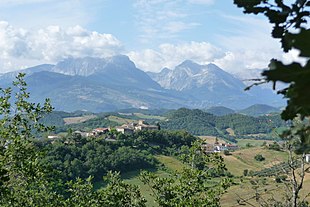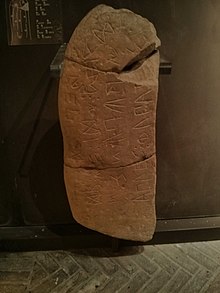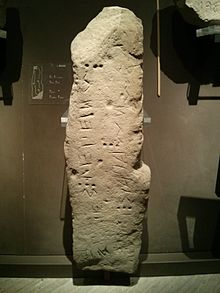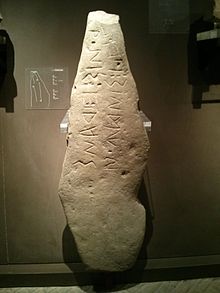South Picene language
| South Picene | |
|---|---|
| Old Sabellic | |
| Native to | Picenum |
| Region | Marche, Italy |
| Era | attested 6th–4th century BC[1] |
Indo-European
| |

South Picene (also known as Paleo-Sabellic, Mid-Adriatic or Eastern Italic)
Corpus



The corpus of South Picene
On a typical gravestone is the representation of the face or figure of the deceased with the inscription in a spiral around it or under it reading in a clockwise direction, or
A complete inventory is as follows:[7]
- the Cippus of Castignano (6th-century BC sandstone pyramid)
- three stelai of Penna Sant'Andrea at Teramo (a whole and two fragmentary limestone obelisks of the 1st half of the 5th century BC)
- the cover of the Campovalano pyxis (7th to 6th centuries BC)
- spiral bracelet of Chietino in Valle del Pescara (5th century BC)
- the Cippus of Cures (limestone)
- the Stele of Loro Piceno (sandstone)
- the Stele of Mogliano (sandstone)
- the Stele of Acquaviva
- the Stele of Belmonte (jointed sandstone)
- the Cippus of Falerone
- the Stele of Servigliano (sandstone)
- a fragment of inscribed sandstone at Belmonte
- the Cippus of Sant'Omero (sandstone)
- two stelai of Bellante (sandstone)
- the Stele of Crecchio (sandstone)
- two cippi of Castel di Ieri (limestone, whole and fragmentary)
- the Statue of Capestrano (limestone, life-size representation of king Nevio Pompuledio, 2nd half of the 7th, 1st half of the 6th centuries BC)
- the Helmet of Bologna (bronze)
- the Helmet of Apulia
Alphabet
The south Picene alphabet, known from the 6th century BC, is most like the southern Etruscan alphabet in that it uses q for /k/ and k for /g/. It is:
- ⟨a b g d e v h i í k l m n o p q r s t u ú f *⟩
⟨.⟩ is a reduced ⟨o⟩ and ⟨:⟩ is a reduced ⟨8⟩, used for /f/.[8]
Phonetics
For consonants South Picene had:[9]
voiceless plosives
|
/p/, /t/, /k/ | represented by | ⟨p⟩, ⟨t⟩, ⟨k q⟩ |
voiced plosives
|
/b/, /d/, /ɡ/ | represented by | ⟨b⟩, ⟨d⟩, ⟨k⟩ |
fricatives
|
/f/, /s/, /h/ | represented by | ⟨:⟩, ⟨s⟩, ⟨h⟩ |
| liquids | /l/, /r/ | represented by | ⟨l⟩, ⟨r⟩ |
nasals
|
/m/, /n/ | represented by | ⟨m⟩, ⟨n⟩ |
| glides | /w/, /i/ | represented by | ⟨v u ú⟩, ⟨i⟩ |
In cases where there is a choice of grapheme the context determines which one applies. For the glides, ⟨v⟩ and ⟨u⟩ were used for word-initial /w/ and ⟨ú⟩ for intervocalic /w/ or in other special contexts. The list above omits special contexts.
Language sample
Inscription Sp TE 2 on a gravestone from Bellante was studied by a linguist of Indo-European studies, Calvert Watkins, as an example of the earliest Italic poetry and as possibly a reflex of a Proto-Indo-European poetic form.[4] In the inscription given below colons are used to separate words; in the original inscription, three vertical dots are used ("the triple interpunct").
- postin : viam : videtas : tetis : tokam : alies : esmen : vepses : vepeten
- "Along the road you see the 'toga' of Titus Alius? buried? in this tomb."[10]
The translation of the questioned items is unclear. For toga Fortson suggests "covering."
Note the
- postin viam videtas
- tetis tokam alies
- esmen vepses vepeten
The first line would be syllabified and read:
- po-stin vi-am vi-de-tas
References
- the Linguist List
- ISBN 978-1-5015-0014-5.
- ^ Helmut Rix Sabellische Texte: Die Texte des Oskischen, Umbrischen und Südpikenischen. Heidelberg: Carl Winter University Press, 2002 pp4f
- ^ a b Watkins 1996, p. 131
- ^ Salmon, Edward Togo (1988). "The Iron Age: the Peoples of Italy". In Boardman, John; Hammond, NGL; Lewis, DM; et al. (eds.). The Cambridge Ancient History. Vol. IV: Persia, Greece and the Western Mediterranean c.525–479 BC. Cambridge; New York: Cambridge University Press. p. 697.
- ^ Stuart-Smith 2004, p. 65
- ^ Calvelli, Alberto. "Lingua e Scrittura". I Piceni (in Italian). antiqui. Retrieved 8 September 2010.
- ^ Stuart-Smith 2004, p. 66
- ^ Stuart-Smith 2004, p. 69
- ^ Fortson, Benjamin W (2010). Indo-European Language and Culture: An Introduction. Blackwell textbooks in linguistics, 19 (2nd ed.). Chichester, U.K.; Malden, MA: Wiley-Blackwell. p. 301.
- ^ Watkins 1996, p. 132
Bibliography
- Stuart-Smith, Jane (2004). Phonetics and philology: sound change in Italic. Oxford: Oxford University Press.
- Watkins, Calvert (1996). How to Kill a Dragon: Aspects of Indo-European Poetics. New York; Oxford: Oxford University Press.
Further reading
- Adiego, Ignacio. "Ancora sul sostrato sudpiceno nei dialetti oschi settentrionali". In: Percorsi linguistici e interlinguistici: studi in onore di Vincenzo Orioles / a cura di Raffaella Bombi, Francesco Costantini. Udine: Forum, 2018, pp. 279–290. 2018.
- de Vaan, Michiel. 2008. Etymological dictionary of Latin and the other Italic languages. Leiden, The Netherlands: Brill.
- Martzloff, Vincent. "Questions d’exégèse picénienne". In: Autour de Michel Lejeune. Actes des journées d'études organisées à l'Université Lumière Lyon 2 – Maison de l'Orient et de la Méditerranée, 2-3 février 2006. (Collection de la Maison de l'Orient méditerranéen ancien. Série philologique, 43) Lyon: Maison de l'Orient et de la Méditerranée Jean Pouilloux, 2009. pp. 359–378. [www.persee.fr/doc/mom_0184-1785_2009_act_43_1_2672]
- Poultney, James. 1951. "Volscians and Umbrians." American Journal of Philology 72: 113–27.
- Wallace, Rex E. 2007. The Sabellic languages of ancient Italy. Languages of the World: Materials 371. Munich: LINCOM.
- Watkins, Calvert. 1995. How to kill a dragon: Aspects of Indo-European poetics. Oxford: Oxford University Press.
- Zamponi, Raoul (2019). "An outline of the South Picene language I: introduction and phonology". Italian Journal of Linguistics. 31 (1): 193–222.
- Zamponi, R. (2019a). "An outline of the South Picene language II: morphology and syntax". Italian Journal of Linguistics. 31 (2): 201–239.
